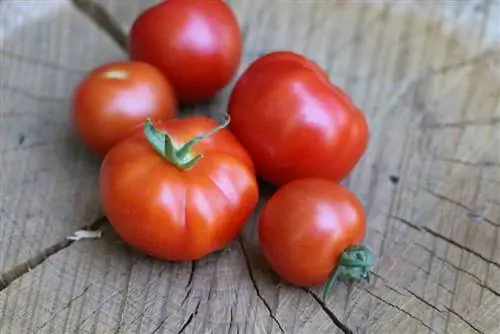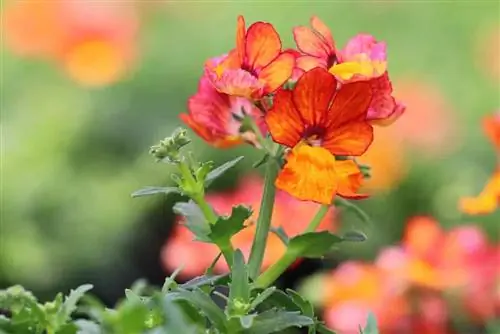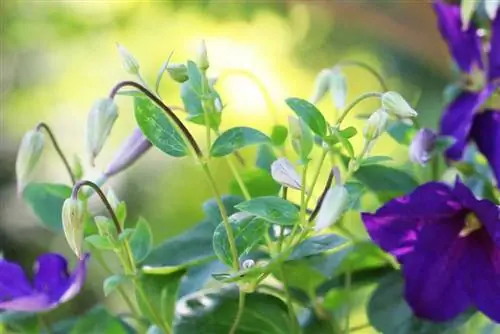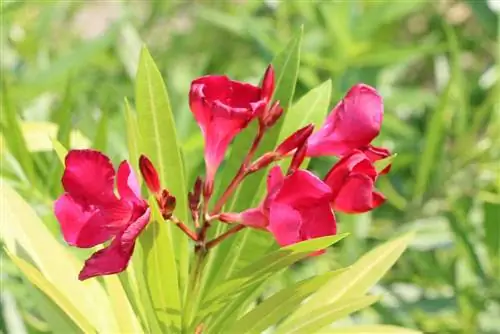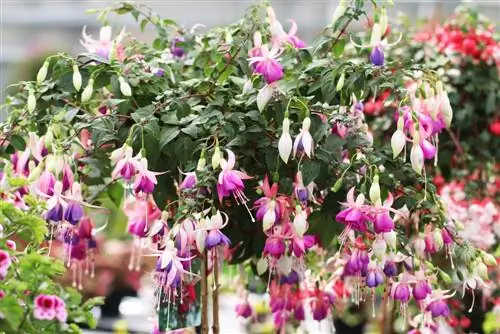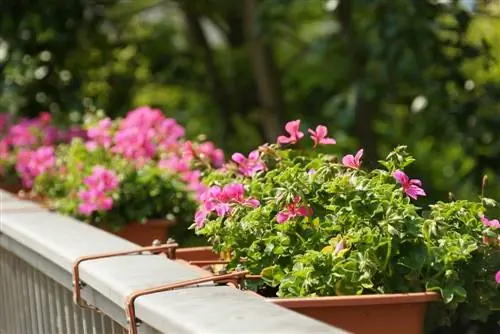- Author admin [email protected].
- Public 2023-12-17 03:39.
- Last modified 2025-01-24 12:45.
Harvesting tomatoes from your own garden not only guarantees freshness; The fruits also taste much more intense and are not contaminated with pesticides. But not everyone has their own garden. Tomatoes (Solanum lycopersicum) can also be grown in a pot on the balcony or terrace. This is quite easy and usually always works if a few important rules are followed.
Location
No matter whether in the garden or in the container, tomatoes love the sun. Even the blazing midday sun cannot harm the nightshade plants. What tomato plants don't like, however, is rain. The location should therefore offer sufficient protection from heavy rainfall and wind. If you don't have a covered balcony, you should at least place the plant close to the wall of the house.
- Light requirements: as sunny as possible
- also tolerates the midday sun
- sheltered from the wind
- rainproof
- warm
Tomato varieties
There are an almost endless number of different tomatoes that differ not only in the color and size of the fruits, but also in their growth behavior.
Climbing tomatoes
Climbing tomatoes grow less in width and more in height. Their long, slender shoots need to be supported with a pole or trellis. In addition, the plants must be regularly cut (pruned) and tied in order to keep their size within limits and to direct them in the desired direction. Climbing tomatoes are very fast-growing and are considered high-yielding. Unfortunately, they are also susceptible to disease.
Bush tomatoes
Bush tomatoes do not shoot as high as climbing tomatoes. For this reason, you don't actually need any climbing aid. However, you can still benefit from it because it keeps the fruit off the ground. Bush tomatoes tend to grow wider and require less care. In addition, they are not as susceptible to pests and diseases. However, bush tomatoes have one disadvantage: their harvest is limited to a short period of time.
Buy plants
Pre-grown tomato plants are available in stores as early as the end of April. You can choose between refined and unprocessed tomato varieties. The selection of tomato varieties is very large. Depending on how much space you have available on the balcony, you should choose either a bush tomato or a slender, but very tall growing variety.
Sowing
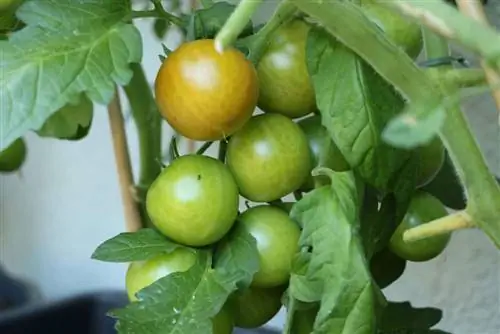
Alternatively, it is of course possible to grow the tomato yourself from seeds. This is particularly useful if you have chosen a tomato variety that is difficult to obtain commercially. From the end of February, the frost-sensitive plants can be grown on a bright windowsill.
In deep seed containers, the young tomato plant develops a thick taproot, just like in the garden soil. This long, vertical root not only provides the plant with better stability, but also makes it more resistant to disease. Plants grown in shallow seed trays do not develop a pronounced taproot, but rather an increasing number of lateral roots. So if you only need a few tomato plants for the balcony, you should sow the seeds in pots that are as deep as possible.
- Time: from the end of February
- Substrate: low in nutrients, sterile
- Cactus soil or seed soil
- fill room temperature substrate into the pots
- press lightly
- moisten with water
- place one or two seeds on the soil
- cover lightly with sand or fine substrate
- Cover sowing containers with lids or plastic bags (prevents excessive evaporation)
- put on the windowsill
- Temperature: 15 to 20 degrees
- Keep substrate slightly moist
- ventilate occasionally
- Germination time: about 10 to 14 days
cultivation
After germination, a balanced ratio of light and heat is necessary. The temperature must not be too high when the sky is overcast, otherwise the tomato plant will suffer from a lack of light. Under these conditions, weak, pale shoots are formed. This phenomenon is also called “horning”. In order to support squat growth with strong, dark green leaves, the plants must be kept a little cooler on dark days. However, the temperature should not fall below 16 degrees. From mid-May, when night frosts are no longer expected, the tomatoes can be placed outdoors. It's best to move into your final plant pot beforehand.
Planting/Repotting
At the beginning of cultivation, a smaller pot is of course sufficient. However, the planter needs to be adjusted as the tomato plant grows. Therefore, regular checks on the root ball are necessary. If you can already see the fine whitish network of roots on the edge of the ball, a larger pot is urgently needed. The material of the planter does not play any role. First and foremost, it is important that the bucket is large and, above all, deep enough. However, before the plant is potted in the new container, a thick layer of drainage must be added to prevent waterlogging.
- Cover exhaust holes with fleece or pottery shards
- fill in a drainage layer a few centimeters thick
- Expanded clay or fine grit are suitable for this
- mix mature compost or horn shavings into the substrate
- fill in some substrate
- Planting depth: until shortly before the first leaf base
- for refined varieties, the grafting point must be above ground level
- fill with soil
- Press the substrate lightly again and again
- water generously
If the seedlings are planted a little deeper, they form additional roots from the trunk. This measure also promotes stable and he althy growth of the tomato plant. If there are several tomatoes in a large pot, the planting distance should be around 60 to 80 cm.
Substrate
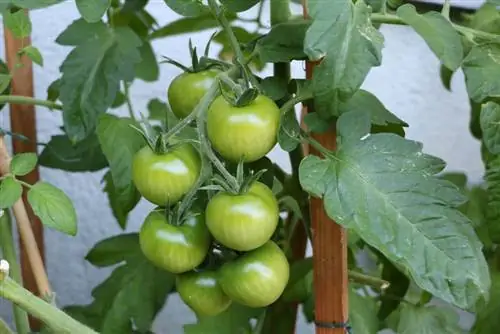
The substrate for a tomato plant should be as nutrient-rich as possible. It is also important that, on the one hand, the soil can drain excess irrigation water well, but on the other hand, it should also be able to store moisture well. A suitable substrate mixture consists of:
- about 60% normal potting or garden soil
- 20% mature compost
- 15% leaf mold
- 5% coarse sand or lava granules
Tip:
Leave about two to three centimeters of space around the edge of the pot. This watering edge prevents the water from washing out the soil.
Plant stick
With all tall-growing types of tomatoes, it is necessary to support the long shoots so that they do not break due to wind and fruit load. Therefore, insert a suitable stick or grid into the substrate when planting. The deeper the plant stick is in the ground, the more stability it offers the plant. Since tomatoes do not climb on their own, the shoots must be tied to the climbing aid with a thick cord or wire. Make sure that there is enough space between the shoot and the rod so that the water and nutrient supply is not cut off when the shoot gets wider.
Planter
One of the most important factors for strong and he althy growth of the tomato plant is a sufficiently large planter. Each individual plant should have at least 15 to 20 liters of volume available for the roots. Although the tomatoes can also be grown in smaller containers, in this case they are not quite as lush and have to be watered and fertilized very frequently.
- choose a sufficiently large planter
- about 20 liters per plant
- with drainage holes
- flat coaster
Care
For a bountiful harvest, tomato plants not only need sun, water and nutrients, but also a little extra care. This includes rooting out the plant at regular intervals. An exception to this are vine tomatoes and bush tomatoes, which naturally grow with plenty of branches. They are generally allowed to spread out to their heart's content.
Pouring
Tomatoes are very thirsty plants. The higher the outside temperatures rise, the more water they need. On hot days, the nightshade plants need to be watered at least in the morning and evening. It's best to leave some water in the saucer on these days so that the roots can absorb it later. Otherwise, the tomato plant must always be watered when the top layer of substrate has already dried out.
The plant cannot tolerate waterlogging at all. A clear sign that the plant is suffering from a lack of water is drooping leaves. In this case, it is urgently necessary to water generously, otherwise the flowers and fruits will be dropped. But avoid watering over the leaves. If the leaves get wet, brown rot can form.
Tip:
While regular watering ensures strong plants and fruits, hobby gardeners who only water rarely but often risk the fruits bursting or developing very hard skin.
Fertilize
Tomatoes are also among the demanding plants when it comes to nutrients. Tomatoes are heavy feeders and for this reason require significantly more fertilizer than other plants. Therefore, provide nutrients at regular intervals. But even if the plants like extremely nutrient-rich soil, you should not overuse the fertilizer. If the amounts of nitrogen are too high, leaf growth is promoted and the fruits suffer. In addition to organic long-term fertilizer, special tomato fertilizers are also suitable, which should be dosed according to the manufacturer's instructions.
- special tomato fertilizer
- Vegetable fertilizer
- Horn shavings or horn meal
- other organic slow-release fertilizers for vegetable plants
Tip:
Fertilize the tomatoes with compost or horn shavings when planting them in the pot. Always work solid fertilizers into the soil.
Simply
So that the plants bear a lot of fruit, new side shoots that form in the leaf axils must be broken out regularly. During so-called thinning, all shoots that form between the leaf stems and the main trunk are removed. Some varieties of tomatoes also tend to produce new leaves behind the fruiting shoots. These also need to be removed. This is the only way the tomato puts its energy into the fruit and not into the formation of new leaves. The lower leaves may be in contact with the ground.
To prevent rot, it makes sense to cut them off. Towards the end of August all new flowers are removed. Since the tomatoes no longer ripen in the short time until the end of the tomato season, the plant can put all its strength into the fruits that are already there. Although bush tomatoes do not have to be thinned out, you should still make sure that there is enough light everywhere for the plant. The leaves must also be well ventilated and be able to dry quickly so that rot diseases do not occur. Light thinning is therefore good for the tomato plant.
Diseases
Many tomato diseases such as leaf and infectious diseases can be avoided by providing the plant with protection from the rain. This is not a problem on covered balconies because the plant just needs to be placed in a place protected from the rain. A roof or a tomato house is useful for prevention on uncovered balconies and roof terraces. In addition, tomato plants must always be watered from below, i.e. never over the leaves.
Brown rot
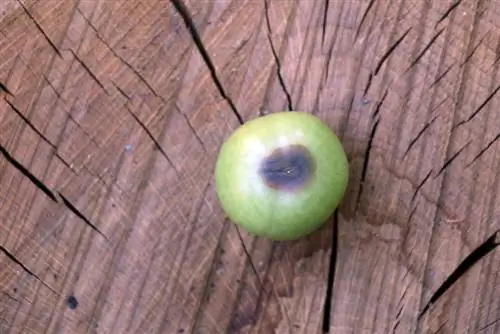
The most feared disease that occurs in tomatoes is brown rot. This disease is caused by a fungus that can spread over long distances using its spores. Initially, black-brown spots are visible on the leaves, later the fruits also become infected. Infected plants can usually no longer be saved. To prevent spread, brown leaves must be removed immediately and disposed of with household waste. Fruits that are not diseased can be harvested and allowed to ripen indoors. The risk of brown rot is highest in warm, humid weather. In contrast to outdoors, tomatoes on a well-protected balcony are better protected from brown rot. Nevertheless, it can also occur when cultivating on the balcony.
Brown spots on the fruits
Sometimes tomatoes have brown discoloration where they attach to the plant. This is either a sign of a lack of calcium. This deficiency occurs when there are too few calcium s alts in the soil. On the other hand, an increased concentration of other nutrient s alts (such as potassium, magnesium or sodium) can also hinder the absorption of calcium. You can prevent brown spots from forming on the fruit by keeping the soil as evenly moist as possible. If a nutrient deficiency is likely (fertilized too rarely or not at all), a special calcium fertilizer sprayed onto the leaves can help.
Unripe tomatoes
Not every year the tomato plants get enough sun, which they need to allow the fruits to ripen. There are often still a lot of unripe fruits hanging on the plant when the days slowly get cooler in September. But these fruits are not yet lost. As soon as the tomatoes show a slight orange color, they can be picked and allowed to ripen indoors.
Conclusion
It's not that difficult to grow tomatoes on the balcony. In addition to plenty of sunshine, the most important prerequisite for he althy growth is a sufficiently large planter and protection from rain. In order for magnificent tomato fruits to form, hobby gardeners must root out, fertilize and water their tomato plants evenly. Then nothing stands in the way of a bountiful harvest.

